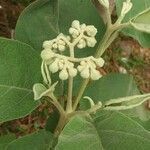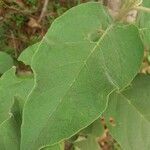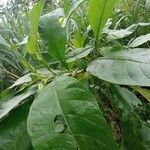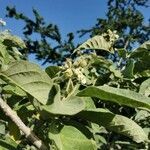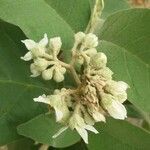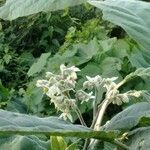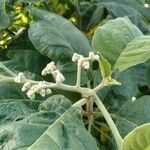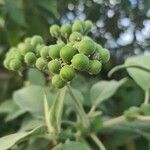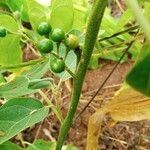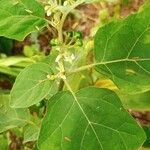Shrubs or small trees 1.5-10 m tall, unarmed, stellate tomentose overall. Petiole stout, 1.5-5.5 cm; leaf blade ovate-oblong or elliptic, 10-29 × 4-12 cm, base cuneate or obtuse, entire or sinuate, apex short acuminate. Inflorescences erect, appearing terminal, flat-topped or rounded panicles; peduncle 3-10 cm. Pedicel 3-5 mm. Calyx campanulate, ca. 1 cm in diam.; lobes ovate, ca. 3 mm. Corolla white; lobes oblong, 6-7 × 3-4 mm. Filaments ca. 1 mm; anthers ca. 2 mm. Style glabrous, 4-6 mm. Berry yellow-brown, globose, ca. 1.2 cm in diam. Seeds compressed, 1-2 mm in diam. Fl. and fr. nearly throughout the year.
Shrub or small tree to 8 m, often with flattened, spreading crown, green or grey-green, densely pubescent with stellate hairs; prickles absent. Leaves ovate-elliptic; lamina 8–24 cm long, 4–15 cm wide, slightly discolorous, entire; petiole 1–10 cm long. Inflorescence branched, many-flowered; peduncle to first fork 3–8 cm long; pedicels 5–10 mm long. Calyx 4–7 mm long; lobes triangular, 1–2.5 mm long. Corolla stellate, 13–19 mm diam., white. Anthers 2.5–3 mm long. Berry globular, 10 mm diam., dull yellow, pubescent. Seeds 1.5–2 mm long, dull yellow.
An evergreen shrub. It grows 2-8 m high. The leaves are oval and woolly. They are 15-30 cm long. The flowers rotate. The lobes are star shaped. They are white or greenish. The stalks are woolly. The fruit is round and orange when ripe. They are 4 cm across.
